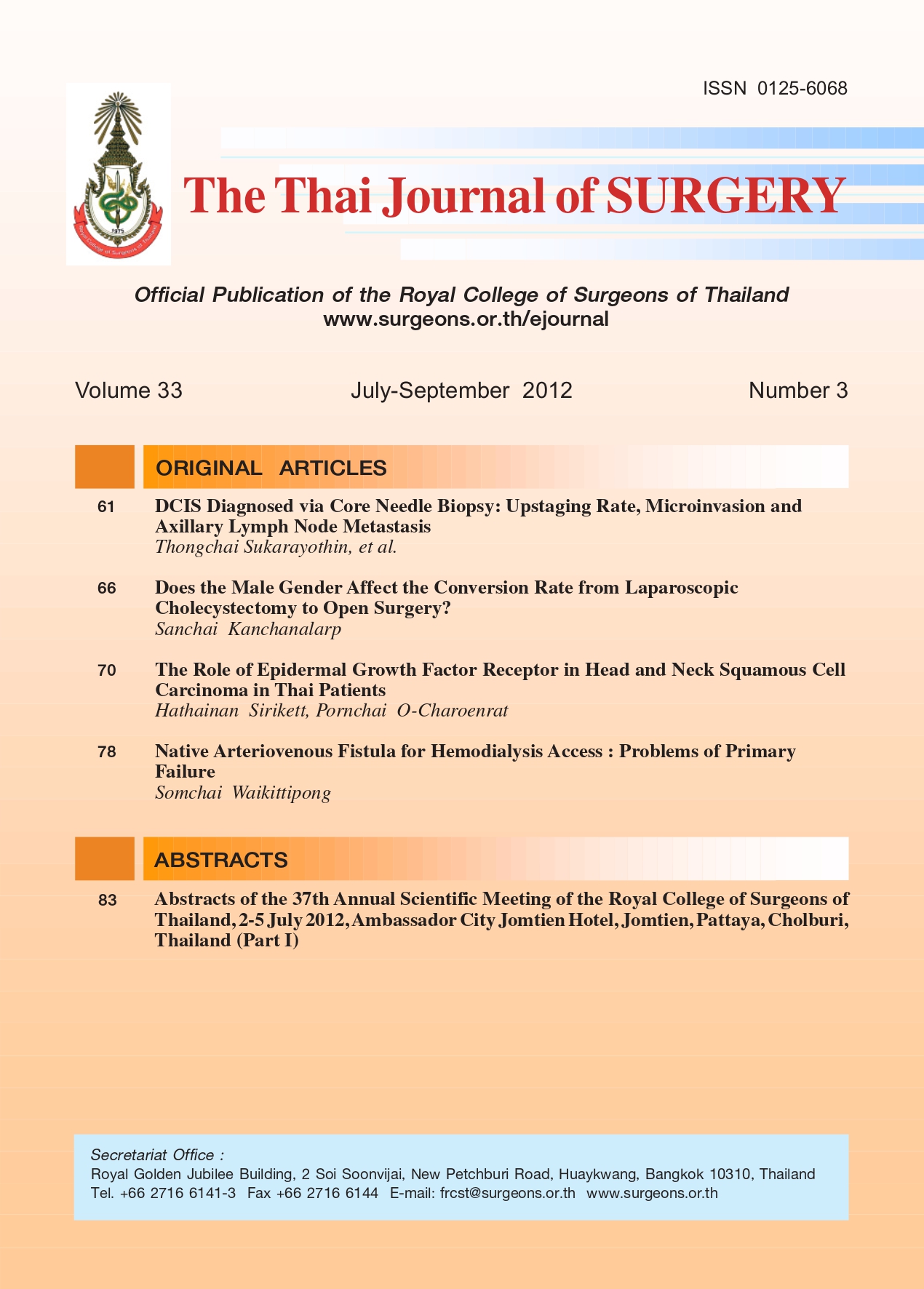Native Arteriovenous Fistula for Hemodialysis Access : Problems of Primary Failure
Keywords:
arteriovenous fistula, hemodialysis vascular accessAbstract
Introduction: Native arteriovenous fistula is recommended as vascular access of choice for long termhemodialysis. However , the major problem of native arteriovenous fistula (AVF) is its primary failure.
Objective: To study the incidence of primary failure of native arteriovenous fistula and determine the
factors associated with its primary failure.
Materials and Methods: All consecutive hemodialysis patients or patients with chronic kidney disease
requiring a permanent vascular access from September 2003 to June 2011 were included in the study. All patients
underwent native arteriovenous fistula as the first procedure. The relation between clinical characteristics with
risk of primary failure was studied using logistic regression analysis.
Results: The primary failure rate was 36.3% (66 of 182 patients). The factors related to an increased risk
of primary failure were female gender (odds ratio(OR) : 1.468,95%, confidence interval (CI) : 0.799-2.698), age
equal or more than 65 years (OR : 1.53, CI : 0.807-2.902), diabetes mellitus (OR : 1.437, CI : 0.756-2.733), AVF
placement at wrist (compared with at elbow) (OR : 1.542, CI : 0.525-4.538), and AVF placement after
hemodialysis (compared with placement before hemodialysis) (OR : 4.375, CI : 1.248-15.338). Timing of AVF
placement (before or after hemodialysis) was statistically significant related to the primary failure rate (p-value
< 0.21).
Conclusion: Primary failure is a major problem for native arteriovenous fistula. Our study showed that
AVF placement after establishment of hemodialysis was significant factor associated with the primary failure. The
brachiocephalic AVF had lower primary failure rate than radiocephalic AVF and could be a good alternative choice in
case of previous unmature radiocephalic AVF.
References
replacement therapy year 2010. [on line]; Available from:
http://www.nephrothai.org/nephrothai.boffice/images_
Upload/news/217/files/Thailand_renal_replacement_
therapy_2010
2. KDOQI clinical practice guidelines for vascular access. Am
J Kidney Dis 2006;48 (Suppl 1): S176-273.
3. Allon M, Robbin ML. Increasing arteriovenous fistulas in
hemodialysis patients: problems and solutions. Kidney Int
2002;62:1109-24.
4. Dixon BS. Why don’t fistulas mature? Kidney Int 2006;70:1413-
22.
5. Miller CD, Robbin ML, Allon M. Gender differences in
outcomes of arteriovenous fistula in hemodialysis patients.
Kidney Int 2003;63:346-52.
6. Huijbregts HJ, Bots ML, Wittens CH, et al. Hemodialysis
arteriovenous fistula patency revisited: results of a
prospective, multicenter initiative. Clin J Am Soc Nephrol
2008;3:714-9.
7. Tordoir JH, Rooyens P, Dammers R, et al. Prospective
evaluation of failure modes in autogenous radiocephalic
wrist access for haemodialysis. Nephrol Dial Transplant
2003;18:378-83.
8. Huijbregts HJ, Bots ML, Moll FL, et al. Hospital specific aspects
predominantly determine primary failure of hemodialysis
arteriovenous fistulas. J Vasc Surg 2007;45:962-7.
9. Sivanesan S, How TV, Bakran A. Sites of stenosis in AV fistula
for haemodialysis access. Nephrol Dial Transplant 1999;
14:118-20.
10. Huber TS, Ozaki K, Flynn TC, et al. Prospective validation of
an algorithm to maximize native arteriovenous fistula for
chronic hemodialysis access. J Vasc Surg 2002;36:452-9.
11. Peterson WJ, Barker J, Allon M. Disparities in fistula maturation
persist despite preoperative vascular mapping. Clin J Am
Soc Nephrol 2008;3:437-41.
12. Hakaim AG, Nalbandian M, Scott T. Superior maturation
and patency of primary brachiocephalic and transposed
basilica vein arteriovenous fistula in patients with diabetes.
J Vasc Surg 1998;27:154-7.
13. Miller PE, Tolwani A, Luscy CP, et al. Predictors of adequacy
of arteriovenous fistulas in hemodialysis patients. Kidey Int
1999;56:275-80.
14. Oliver MJ, McCann RL, Indridason OS, et al. Comparison of
transposed brachiobasilic fistulas to upper arm grafts and
brachiocephalic fistulas. Kidney Int 2001;60:1532-9.
15. Lee T, Barker J, Allon M. Comparison of survival of upper arm
arteriovenous fistulas and grafts after failed forearm fistula.
J Am Soc Nephrol 2007;18:1936-41.
16. Lok CE. Fistula first initiative: advantages and pitfalls. Clin J
Am Soc Nephrol 2007;2:1043-53.
Downloads
Published
How to Cite
Issue
Section
License
Articles must be contributed solely to The Thai Journal of Surgery and when published become the property of the Royal College of Surgeons of Thailand. The Royal College of Surgeons of Thailand reserves copyright on all published materials and such materials may not be reproduced in any form without the written permission.



